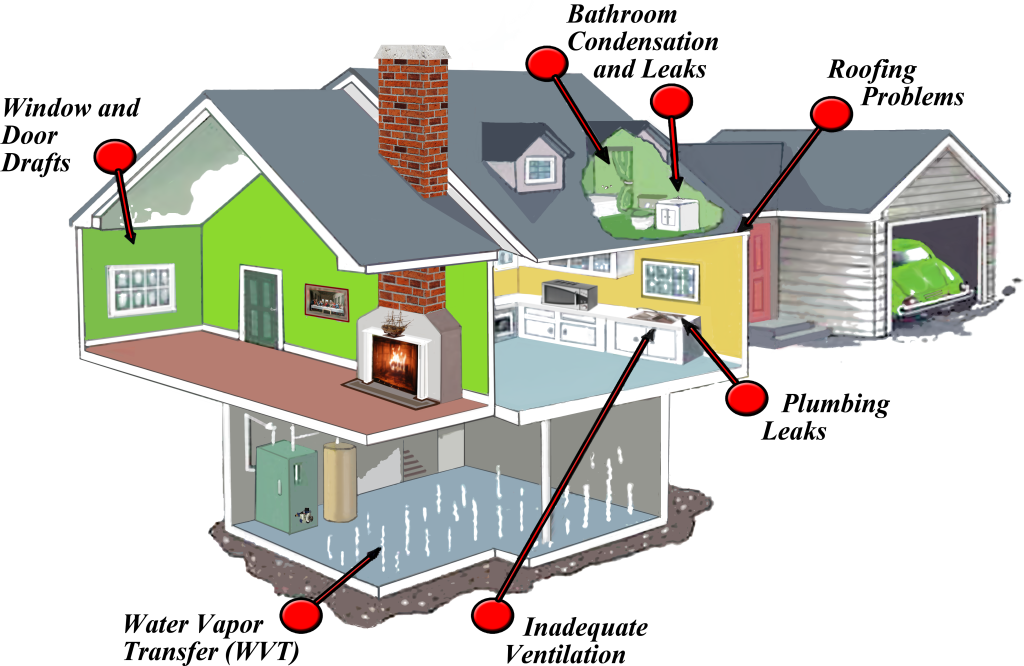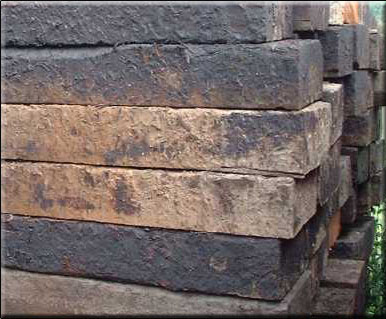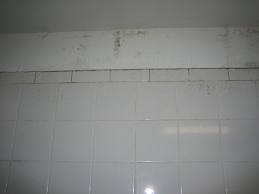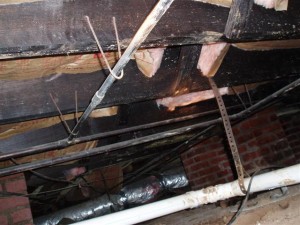Mold in Basements, Attics and More: Where Toxic Mold May Be Hiding in Your Home
If you are like most homeowners, you probably haven’t checked out your basement, attic or floorboards recently for signs of toxic mold. Many families have a big secret hiding in their walls and flooring that may be causing health problems and damaging the overall structure of their home. Mold in basements, attics and other hidden areas of the home is a situation that can quickly grow out of hand, and before you know it, major damage has already been done and your family’s health has already been put in serious jeopardy. It’s a silent danger that is already probably growing in parts of your home.
Conditions for mold …
- Supply some food: Wood, drywall, wallpaper, fabrics and even the paint used throughout your home are all likely candidates for mold … they are all mold food.
- Add some moisture: The appliances that we use to “power” our lives, including washing machines and dishwashers, all add to moisture in the air. Then there are the leaks, water vapor transfer and condensation issues too.
- Heat: Not a whole lot, just the sort of heat we need to feel comfortable. Now, you have the perfect breeding ground for mold.
The key to mold prevention and elimination is moisture: that’s the one variable we can control.
Have you recently investigated your home for signs of moisture infiltration and mold growth? If you smell musty odors or are suffering from chronic respertory issues, rashes, dizziness or headaches then do a quick home mold inspection. Look at the areas noted in the picture to determine if there is a moisture / mold problem.
If you find mold … look around, can you find the source of the moisture? If so, eliminate it.
If you find or smell mold but can’t locate it or determine the source of the moisture, then contact a professional – the sooner the better! Working with the pros is sometimes the only way to resolve the problem completely and prevent it from coming back again.
Mold Assessment and Mold Remediation: Why You Need the Pros
Whenever you have a combination heat, moisture, food and oxygen in any environment, mold can and will grow, spreading to just about any surface both inside and outside of the home. While the majority of molds are harmless, there are many types of molds that are highly toxic. The “bad” types of mold may not bother you when you are outdoors and the spores are more dispersed throughout the air, but when you are indoors, the increased concentration of the spores found in the air can cause illness. Over time, prolonged exposure to mold in the home and the workplace can result in long-term health problems.
 Mold assessment and mold remediation takes care of your mold problems, addressing any areas that need treatment and providing valuable information about mold prevention. Mold removal experts are trained to locate areas of mold and can also provide an assessment on your entire home, pointing out areas that are likely candidates for a mold problem. For many homeowners who don’t know the extent of their mold problem, this first step in the process is often a big wake-up call.
Mold assessment and mold remediation takes care of your mold problems, addressing any areas that need treatment and providing valuable information about mold prevention. Mold removal experts are trained to locate areas of mold and can also provide an assessment on your entire home, pointing out areas that are likely candidates for a mold problem. For many homeowners who don’t know the extent of their mold problem, this first step in the process is often a big wake-up call.
Controlling mold once it has been removed is done by controlling moisture. This requires completely drying all of the areas damaged by moisture that comes in from leaky pipes, roofs and other leak-prone areas. It’s also important to remove moldy building materials that you may be storing in areas of the basement or attic, as moldy ceiling tiles, carpeting or other items that are made from porous materials can quickly turn into a moldy problem. By keeping your home as dry and clean as possible and working with the experts, you can reduce your mold problems for good.
Mold and Mildew Remediation Tips: Caveat Emptor: What to consider before you call in the pros
Mold and mildew remediation is an important issue that can greatly impact both your health and your wallet. Mold is often just a sign of a much larger problem that can involve problems with moisture buildup and issues with poor ventilation that you may not have known about. Homeowners that reside in environment that have high humidity are especially prone to mold problems.
To take care of mold problems in the home, you need to work with a contractor who can provide both the inspection and the repairs needed to address the areas of mold that are found. If you are collecting multiple bids for the job, be cautious of overly cheap bids or big promises that seem too good to be true.
Products and services that don’t attack the source of mold and that work as short-term solution are certainly out there, but it is definitely in the homeowners interest to pay for services that are designed to both kill the existing mold and prevent it from returning.
I recommend assessing contractors and products on more than cost and referrals … consider these three factors too:
1. Prevention: What actions are being taken to prevent future problems? There are endless ads and sites that will assure elimination of mold, and pre and post remediation reports will disclose success, but too often it is SHORT TERM SUCCESS.
2. Read between the Warranty lines: Is the contractor’s and/or manufacturer’s warranty iron clad or are there so many ifs and buts that the warranty has little real value? Beware 20 year, 30 year, lifetime warranties that have exclusions based on water / moisture issues. These warranties seem to protect you unless stuff gets wet. I’m not going to suggest that this makes such warranties useless, but I do have to wonder if the value is not much more than making the home owner feel safe.
3. Homeowners should also beware unnecessary demolition and re-build costs. If existing structures can be saved: save them and a chunk of cash!
When it comes to your home and the health of your family, mold remediation is something that shouldn’t be taken lightly. Many homeowners don’t realize how much mold can damage the actual structure of their home until they find themselves having to replace an entire wall or area of the basement. By taking wise and informed steps you can rest assured that your home and your family and your wallet will be protected.
Creosote Removal / Remediation
Creosote remediation and containment is one task that has historically involved the use of strong chemical sprays and laborious scraping in cramped quarters like crawl spaces and attics. Creosote is that unpleasant substance that is most often used to preserve the wood used in damp or wet locations … think dock pilings, telephone poles, and oceanfront construction timber. While creosote is definitely one of the best preservatives for wood, it is highly toxic.
Exposure to creosote can lead to serious health problems over time. Homeowners should be careful not to come in physical contact with creosote and should also take precautions to protect themselves from creosote off-gassing or volatilization. Volatilization occurs when the creosote surface residues change from a solid state to a gas or vapor. Once airborne, creosote gases can permeate all the nooks and crannies of a home.
The EPA does not recommend the use of creosote- or pentachlorophenol-treated wood in the interiors of homes because these chemicals may volatilize from the wood into the indoor air. They can be irritating to the respiratory tract and EPA considers creosote to be a “probable human carcinogens” based on scientific studies. The sale of CCA-treated wood for residential uses has been phased out.
EPA and some contractors suggest that you can reduce exposure to creosote pesticides if treated wood is already present in your home by painting the wood with two coats of shellac, varnish or an oil-based paint, this reducing off-gassing of the creosote pesticides.
Unfortunately, in the real world applications: shellacs, varnishes and oil paints generally do not stick to creosote and the phenomenon of creosote off-gassing is not solved.
EnviroShield products create an effective barrier to creosote off-gassing and will adhere to surfaces where are other products fail.
The Best Ways to Get Rid of Mold In the Bathroom
We have all battled mold and mildew in the bathroom, sometimes with minimal success. Mold in the bathroom is common thanks to the warm, moist and dark conditions that are so conducive to its growth. To keep mold and mildew at bay, you can try reducing the humidity in your bathroom by running the fan or opening a window after you take a shower. Since mold grows best in stagnant conditions, keeping the airflow going when there is excess moisture in the room decreases the chances of mold forming.
If mold persists many homeowners are now relying on anti-fungal coatings for walls and ceilings. EnviroShield coatings can be manufactured to any color and luster.
If you are finding yourself constantly scrubbing at mold and mildew when you are cleaning bathroom tiles, you may actually have a bigger problem that lies below the surface. Mold can easily grow underneath tiles and grout in the bathroom, as cracks start to form and excess moisture is able to sneak in.
Situations like these often require the tiles to be removed and the source of mold treated. This is best done by a professional, who can ensure that the problem is completely taken care of and that it won’t just happen again a few months down the road. Before replacing tiles coat the new surface with an anti-fungal coating. It makes a good base for the tile and will not support the growth of mold if moisture once again finds a path underneath the grout and tiles.
How to Get Rid of Creosote Smell in Basements and Crawl Spaces
Creosote smell in basements and crawl spaces: Many seaside/waterfront homes built in the early 1900s to the 1980s were built using floor joists, beams, posts and sheathing that were treated with creosote, a tar like substance (think of telephone poles) to prevent termite infestations and wood rot. Even years later, when the house has gone through generations of families living there, this treatment can still cause intense odors to permeate throughout the home.
Beware: Creosote doesn’t just smell bad; it also gives off toxic fumes (off-gassing). This off-gassing can leak into living spaces, even seep into heating and cooling air ducts and spread throughout a home, possibly leading to breathing problems, asthma and respiratory infections. It’s an especially big issue for those who already have a health problem or a weakened immune system.
Luckily, there are steps that homeowners can take to get rid of that nasty and potentially harmful creosote off-gassing.
Creosote removal is a daunting if not impossible task … encapsulating creosote-treated framing and sheathing materials is recommended, easier and costs less.
Over the years, I have heard and read about various coating products (even paper!) for creosote encapsulation. Unfortunately the long term efficacy of these products has been dismal, though I must always consider my sample as biased, since homeowners end up contacting me when other products fail.
Creosote encapsulation attempts usually fail due to bad prep, temperature, moisture or back pressure issues … the encapsulation product falls off, peels or even blows off.
While I try to write these blogs from an informative and not a marketing viewpoint, this time I am recommending EnviroShield products to encapsulate creosote simply because they stick … really well. Why they adhere so well is another blog posting.
Basics Every Homeowner Should Know About Mold and Mildew Removal
When it comes to mold and mildew removal and encapsulation, there are some important tips that homeowners should know that can save thousands of dollars in home repairs down the road.
Mold can often be mistaken for just dirt on your walls or window sills, but in many cases, the mold is just dispersed in a way that makes the area simply look dirty and not like an area infested with tiny mold spores.
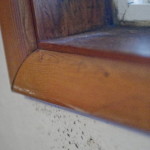
Mold forming on and around a poorly insulatd window sill
Visible areas of mold and mildew in the home are caused by some sort of moisture problem that is located
- On or behind walls, or
- On, above or below floors and ceilings.
So, think beyond the mold to the water source. If the moisture source isn’t corrected, then expensive repairs to replace rotten wood and even entire walls might follow.
Mold needs water to take hold and flourish, but moisture from even just condensation near windows and outlets, can support mold. For example: Look at the seal around your refrigerator and freezer … Odds are you will find mold. If so, a mild solution of bleach and water (ten parts water to one part bleach) will kill the existing mold.
Another common problem area is ductwork, if mold forms on the ceiling under a duct or register and there’s no sign of a roof leak, then the moisture supplier may be badly insulated ductwork. In the summertime, warm moist air condenses and forms water on ducts carrying cold air through the attic or crawl space. The condensation is a sign that the duct is un-insulated or missing a vapor barrier. Eventually the water saturates the insulation and drywall and mold spores (which are everywhere) take root.
In cold weather, the reverse happens. Moisture forms anywhere warm air escapes, like unsealed joints between duct sections.
Inspect pipes and drains for leaks. If you see mold near water pipes, waste lines, icemaker lines or plumbing fixtures, chances are the mold is feeding off a nearby leak. Let the water run while you check the pipes and surrounding area for damp spots. Remember that water can travel in any direction—down, sideways or even up when it wicks into absorbent material like drywall—so the actual leak may be some distance from the mold.
If mold is growing on an exterior wall or ceiling, first look for a leak in the wall or roof. Measure from the moldy area to a reference point like a door, and then find the spot on the other side of the wall or ceiling.
Closely inspect nearby vents, roof flashing, decks, window wells and anywhere wood is rotting. Look for ground sloping toward the house and downspouts emptying next to the wall. If the ground around the house gets too wet, moisture will wick into the foundation or slab and become persistent dampness.
Mold removal experts often recommend using an ant-fungal spray that treats the area in order to kill of the existing mold, but REMEMBER this will not prevent mold and mildew from returning if the underlying moisture problem is not corrected … but it’s still a good gap-stop measure until a professional can assess and cure the problem.
If you see or smell re-occurring mold infestations in your home or if anyone in your family is suffering from reoccurring /persistent dizziness, headaches or nausea, then you should contact a certified and trained mold removal expert for an inspection.
When to Call a Mold Removal Company
Many homeowners don’t realize that they have a truly bad mold problem until it becomes too dangerous to live in their home and/or also incredibly expensive to fix the problem.
Calling a mold removal company as soon as you suspect that you may have a mold problem that you cannot identify and repair.
Indicators of a mold infestation: In additon to the visual evidience and musty smells, you may have a mold problem if you or your family suffer chronic allergy and/or irritations. symptoms of mold exposure. Although symptoms will vary, the most common symptoms seen in people exposed to mold indoors include:
- Nasal and sinus congestion
- Eye irritation, such as itchy, red, watery eyes
- Respiratory problems, such as wheezing and difficulty breathing
- Cough
- Throat irritation
- Skin irritation, such as a rash
- Headache
Mold removal specialists are trained to locate the mold and source; they can identify exactly what kinds of molds have taken root and create the best plan of attack for mold remediation.
Waiting too long to call a professional can be both a danger to your health and bad for your budget. A mold removal expert can perform a full inspection so that areas of mold and dampness can be located and corrected before extensive damage occurs.
Contact a professional: It’s the best way to protect you and your family from the dangers and expense of living with mold in your home.
Coming Soon
More articles coming soon.
-
Basics Every Homeowner Should Know About Mold and Mildew Removal
-
When to Call a Mold Removal Company
-
Water Vapor Transfer (WVT) – how to minimize.
-
Creosote: It was there, it was gone – then a hurricane came.
-
A NY,NY success story, If You Can Make It There …


